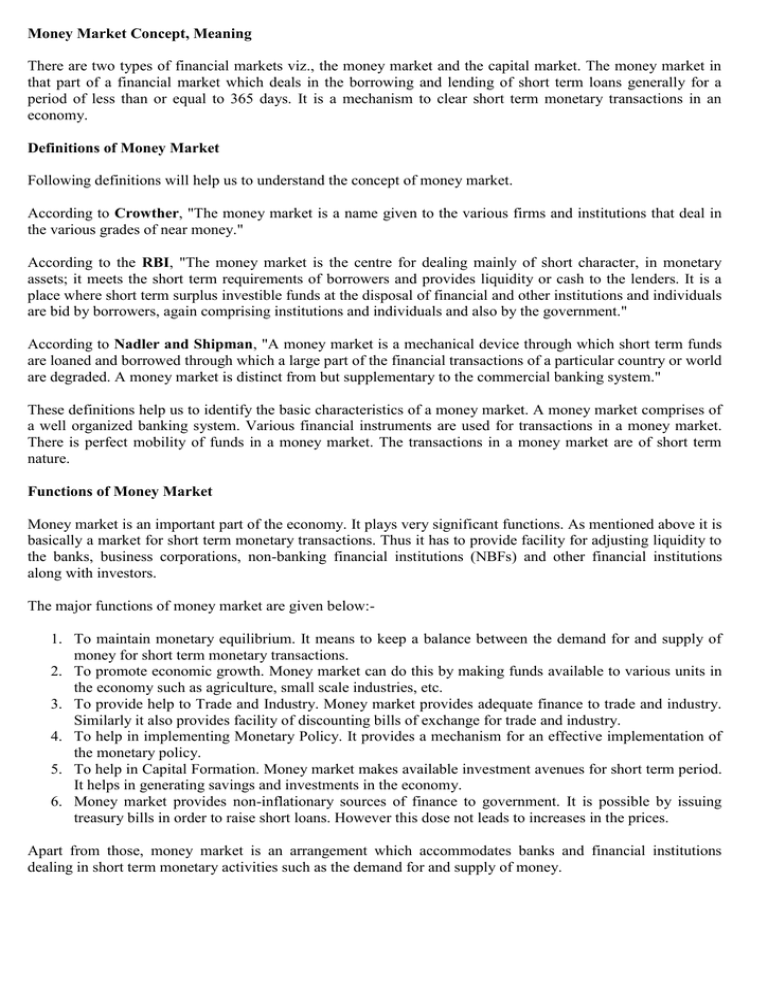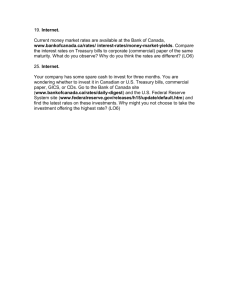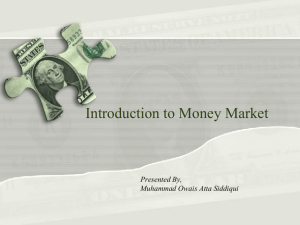Definitions of Money Market
advertisement

Money Market Concept, Meaning There are two types of financial markets viz., the money market and the capital market. The money market in that part of a financial market which deals in the borrowing and lending of short term loans generally for a period of less than or equal to 365 days. It is a mechanism to clear short term monetary transactions in an economy. Definitions of Money Market Following definitions will help us to understand the concept of money market. According to Crowther, "The money market is a name given to the various firms and institutions that deal in the various grades of near money." According to the RBI, "The money market is the centre for dealing mainly of short character, in monetary assets; it meets the short term requirements of borrowers and provides liquidity or cash to the lenders. It is a place where short term surplus investible funds at the disposal of financial and other institutions and individuals are bid by borrowers, again comprising institutions and individuals and also by the government." According to Nadler and Shipman, "A money market is a mechanical device through which short term funds are loaned and borrowed through which a large part of the financial transactions of a particular country or world are degraded. A money market is distinct from but supplementary to the commercial banking system." These definitions help us to identify the basic characteristics of a money market. A money market comprises of a well organized banking system. Various financial instruments are used for transactions in a money market. There is perfect mobility of funds in a money market. The transactions in a money market are of short term nature. Functions of Money Market Money market is an important part of the economy. It plays very significant functions. As mentioned above it is basically a market for short term monetary transactions. Thus it has to provide facility for adjusting liquidity to the banks, business corporations, non-banking financial institutions (NBFs) and other financial institutions along with investors. The major functions of money market are given below:1. To maintain monetary equilibrium. It means to keep a balance between the demand for and supply of money for short term monetary transactions. 2. To promote economic growth. Money market can do this by making funds available to various units in the economy such as agriculture, small scale industries, etc. 3. To provide help to Trade and Industry. Money market provides adequate finance to trade and industry. Similarly it also provides facility of discounting bills of exchange for trade and industry. 4. To help in implementing Monetary Policy. It provides a mechanism for an effective implementation of the monetary policy. 5. To help in Capital Formation. Money market makes available investment avenues for short term period. It helps in generating savings and investments in the economy. 6. Money market provides non-inflationary sources of finance to government. It is possible by issuing treasury bills in order to raise short loans. However this dose not leads to increases in the prices. Apart from those, money market is an arrangement which accommodates banks and financial institutions dealing in short term monetary activities such as the demand for and supply of money. Structure and Components of Indian Money Market The entire money market in India can be divided into two parts. They are organised money market and the unorganized money market. The unorganised money market can also be known as an unauthorized money market. Both of these components comprise several constituents. The following chart will help you in understanding the organisational structure of the Indian money market. Structure of Indian Money Market After studying above organisational chart of the Indian money market it is necessary to understand various components or sub markets within it. They are explained below. Call Money Market : It an important sub market of the Indian money market. It is also known as money at call and money at short notice. It is also called inter bank loan market. In this market money is demanded for extremely short period. The duration of such transactions is from few hours to 14 days. It is basically located in the industrial and commercial locations such as Mumbai, Delhi, Calcutta, etc. These transactions help stock brokers and dealers to fulfill their financial requirements. The rate at which money is made available is called as a call rate. Thus rate is fixed by the market forces such as the demand for and supply of money. Commercial Bill Market : It is a market for the short term, self liquidating and negotiable money market instrument. Commercial bills are used to finance the movement and storage of agriculture and industrial goods in domestic and foreign markets. The commercial bill market in India is still underdeveloped. Treasury Bill Market : This is a market for sale and purchase of short term government securities. These securities are called as Treasury Bills which are promissory notes or financial bills issued by the RBI on behalf of the Government of India. There are two types of treasury bills. (i) Ordinary or Regular Treasury Bills and (ii) Ad Hoc Treasury Bills. The maturity period of these securities range from as low as 14 days to as high as 364 days. They have become very popular recently due to high level of safety involved in them. Market for Certificate of Deposits (CDs) : It is again an important segment of the Indian money market. The certificate of deposits is issued by the commercial banks. They are worth the value of Rs. 25 lakh and in multiple of Rs. 25 lakh. The minimum subscription of CD should be worth Rs. 1 Crore. The maturity period of CD is as low as 3 months and as high as 1 year. These are the transferable investment instrument in a money market. The government initiated a market of CDs in order to widen the range of instruments in the money market and to provide a higher flexibility to investors for investing their short term money. Market for Commercial Papers (CPs) : It is the market where the commercial papers are traded. Commercial paper (CP) is an investment instrument which can be issued by a listed company having working capital more than or equal to Rs. 5 cr. The CPs can be issued in multiples of Rs. 25 lakhs. However the minimum subscription should at least be Rs. 1 cr. The maturity period for the CP is minimum of 3 months and maximum 6 months. This was introcuced by the government in 1990. Short Term Loan Market : It is a market where the short term loan requirements of corporates are met by the Commercial banks. Banks provide short term loans to corporates in the form of cash credit or in the form of overdraft. Cash credit is given to industrialists and overdraft is given to businessmen.







